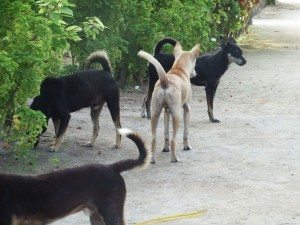The dogs of Bali – by Dr. Amanda Glew
When travelling in foreign countries, sometimes the most upsetting thing is the state of the animals. I have found that travelling in warmer countries, we seem to see more – I know they are there in developed countries as well, but somehow because ¾ of the time it is colder, we don’t see them as easily. So it is easy to make broad North American judgements on the developing countries, but we sometimes don’t look at how our own treatment is of animals.
As a tourist, we turn a blind eye on everything but what we want to see. I mean, why not? We are on holiday, we have paid to go away, we want to see beauty, and enjoy things. As I get older, I find this is becoming harder and harder, especially in countries where the people barely survive, have few rights, and live day to day. So of course, animals are next on the list.
This was my first trip to East Asia- we decided to spend 9 days in Bali, one part of the Indonesian Archipelago, before going on a dive boat.
The first thing is to say about Bali, is get out of the cities. We took a few days to catch our breath after our 25 hours flight, and being 13 hours ahead, our internal clocks were off. Then we went into the countryside.
We took a hike through a village with a guide who was self taught English- and walked through rice fields, along the water ditches which channel water down the terraced fields. Along the walk, villagers had set up small Warungs- small shops, with food, coconuts and whatever else. Inevitably, there would be a dog or two to greet you. As time went on, I realized they were everywhere. Although a standard mix (like short haired Shiba Inu, with varying colors) they are mainly in good condition, very cocky and happy. I have asked each of the guides, and they all say the same- the dogs are kept by each household to guard, mainly against evil spirits. If they bark, it is to indicate some evil, and the house will then do what is needed to keep it out. Of course, however, nothing is neutered.

We see them wondering along the roads. How they are not hit, is beyond me. The main roads are only driven at 50-60 km/hour, but there is little space, and they rarely swerve. I would close my eyes, waiting for the thump indicating one had been hit- but indeed, they seem to move away at the last moment. The nonchalance of them standing by the road was astonishing to me as someone used to North American standards. They would be snoozing in restaurants, on top of piles of earth, on the beach.
There is something glorious about seeing loose dogs. I would spend an hour watching the interactions when 2-3 dogs would mix while taking a coffee on an outside Warung- the submissive one yawning, the bolder one standing stiffly, and if pushed, raising a lip. When allowed to express their behaviors, in this way, you see it is really a language. A canine language.
I imagine it is a tough life, being a dog in Bali. However, for those who manage to survive it, there is always plenty of food from the many offerings on the street, and the weather is good. If given a choice, I think I would rather be a dog of Bali, rather than one of our pampered, cosseted, rarely get walked, or if walked, always on a leash, obese dogs– that I see so commonly in my practice.
 Montreal Dog Blog Montreal's Online Dog Park
Montreal Dog Blog Montreal's Online Dog Park




